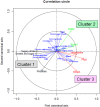Dietary patterns differently associate with inflammation and gut microbiota in overweight and obese subjects
- PMID: 25330000
- PMCID: PMC4203727
- DOI: 10.1371/journal.pone.0109434
Dietary patterns differently associate with inflammation and gut microbiota in overweight and obese subjects
Abstract
Background: Associations between dietary patterns, metabolic and inflammatory markers and gut microbiota are yet to be elucidated.
Objectives: We aimed to characterize dietary patterns in overweight and obese subjects and evaluate the different dietary patterns in relation to metabolic and inflammatory variables as well as gut microbiota.
Design: Dietary patterns, plasma and adipose tissue markers, and gut microbiota were evaluated in a group of 45 overweight and obese subjects (6 men and 39 women). A group of 14 lean subjects were also evaluated as a reference group.
Results: Three clusters of dietary patterns were identified in overweight/obese subjects. Cluster 1 had the least healthy eating behavior (highest consumption of potatoes, confectionary and sugary drinks, and the lowest consumption of fruits that was associated also with low consumption of yogurt, and water). This dietary pattern was associated with the highest LDL cholesterol, plasma soluble CD14 (p = 0.01) a marker of systemic inflammation but the lowest accumulation of CD163+ macrophages with anti-inflammatory profile in adipose tissue (p = 0.05). Cluster 3 had the healthiest eating behavior (lower consumption of confectionary and sugary drinks, and highest consumption of fruits but also yogurts and soups). Subjects in this Cluster had the lowest inflammatory markers (sCD14) and the highest anti-inflammatory adipose tissue CD163+ macrophages. Dietary intakes, insulin sensitivity and some inflammatory markers (plasma IL6) in Cluster 3 were close to those of lean subjects. Cluster 2 was in-between clusters 1 and 3 in terms of healthfulness. The 7 gut microbiota groups measured by qPCR were similar across the clusters. However, the healthiest dietary cluster had the highest microbial gene richness, as evaluated by quantitative metagenomics.
Conclusion: A healthier dietary pattern was associated with lower inflammatory markers as well as greater gut microbiota richness in overweight and obese subjects.
Trial registration: ClinicalTrials.gov NCT01314690.
Conflict of interest statement
Figures




References
-
- Schulze MB, Hoffmann K, Kroke A, Boeing H (2001) Dietary patterns and their association with food and nutrient intake in the European Prospective Investigation into Cancer and Nutrition (EPIC)-Potsdam study. Br J Nutr 85: 363–73. - PubMed
-
- Costacou T, Bamia C, Ferrari P, Riboli E, Trichopoulos D, et al. (2003) Tracing the Mediterranean diet through principal components and cluster analyses in the Greek population. Eur J Clin Nutr 57: 1378–85. - PubMed
-
- Kant AK (2004) Dietary patterns and health outcomes. J Am Diet Assoc 104: 615–35. - PubMed
-
- Newby PK, Weismayer C, Akesson A, Tucker KL, Wolk A (2006) Longitudinal changes in food patterns predict changes in weight and body mass index and the effects are greatest in obese women. J Nutr 136: 2580–7. - PubMed
-
- Schulze MB, Fung TT, Manson JE, Willett WC, Hu FB (2006) Dietary patterns and changes in body weight in women. Obesity (Silver Spring) 14: 1444–53. - PubMed
Publication types
MeSH terms
Substances
Associated data
LinkOut - more resources
Full Text Sources
Other Literature Sources
Medical
Research Materials

